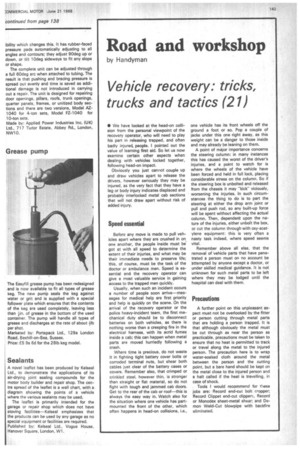Road and workshop
Page 145

If you've noticed an error in this article please click here to report it so we can fix it.
by Handyman
Vehicle recovery: tricks, trucks and tactics (21)
• We have looked at the head-on collision from the personal viewpoint of the recovery operator, who will need to play his part in releasing trapped, and often badly injured, people. I pointed out the value of learning first aid. So let us now examine certain other aspects when dealing with vehicles locked together, following head-on impact.
Obviously you just cannot couple up and draw vehicles apart to release the drivers, however seriously they may be injured, as the very fact that they have a leg or body injury indicates displaced and probably interlocked metal cab sections that will not draw apart without risk of added injury.
Speed essential
Before any move is made to pull vehicles apart where they are crushed in on one another, the people inside must be got at with all speed to determine the extent of their injuries, and what may be their immediate needs to preserve life; this, of course, must be the task of the doctor or ambulance men. Speed is essential andthe recovery operator can give a most valuable service in gaining access to the trapped men quickly.
Usually, when such an incident occurs a number of people soon arrive—messages for medical help are first priority and help is quickly on the scene. On the arrival of the recovery operator or the police heavy-incident team, the first mechanical duty should be to disconnect batteries on both vehicles, as there is nothing worse than a creeping fire in the electrical harness, with its acrid fumes inside a cab; this can happen when metal parts are moved hurriedly following a crash.
Where time is precious, do not waste it in fighting tight battery cover bolts or corroded terminal nuts, but shear both cables just clear of the battery cases or covers. Remember also, that crimped or crinkled steel, however thin, is stronger than straight or flat material, so do not fight with tough and jammed cab doors. Get to the rear of the cab or roof—this is always the easy way in. Watch also for the situation where one vehicle has partmounted the front of the other, which often happens in head-on collisions, i.e., one vehicle has its front wheels off the ground a foot or so. Pop a couple of jacks under this one right away, as this weight can be a danger to those inside and may already be leaning on them.
A point of major importance concerns the steering column: in many instances this has caused the worst of the driver's injuries, and a point to watch for is where the wheels of the vehicle have been forced and held in full lock, placing considerable stress on the column. So if the steering box is unbolted and released from the chassis it may "kick" viciously, worsening the injuries. In such circumstances the thing to do is to part the steering at either the drop arm joint or pull and push rod, so any built-up force will be spent without affecting the actual column. Then, dependent upon the nature of the injuries, either unbolt the box, or cut the column through with oxy-acetylene equipment: this is very often a nasty task indeed, where speed seems vital.
Remember above all else, that the removal of 'vehicle parts that have penetrated a person must on no account be attempted by anyone except a doctor, or under skilled medical guidance. It is not unknown for such metal parts to be left where they may be lodged until the hospital can deal with them.
Precautions
A further point on this unpleasant aspect must not be overlooked by the fitter or person cutting through metal parts that are holding a person trapped. It is that although obviously the metal must be cut through as near the person as practicable, precautions must be taken to ensure that no heat is permitted to track or travel along the metal to the injured person. The precaution here is to wrap water-soaked cloth around the metal between the person and the cutting point, but a bare hand should be kept on the metal close to the injured person and a halt called if the heat is travelling, in case of shock.
Tools I would recommend for these jobs are: Record end-cut bolt cropper; Record Clippet end-cut clippers, Record or Monodex sheet-metal shear; and Demon Weld-Cut blowpipe with backfire eliminated.








































































































































































































